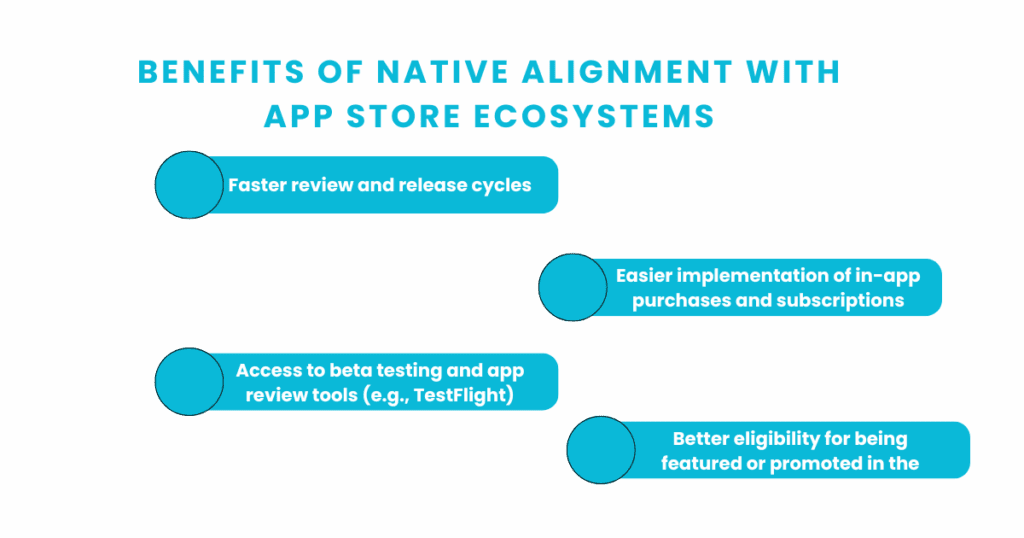
Top Benefits of Native Mobile App Development
When was the last time you opened your phone just to make a call? Chances are, your answer reflects how dramatically mobile usage has evolved.
For most users today, smartphones serve a far greater purpose than voice communication. They are essential tools for managing daily life—enabling everything from banking and healthcare access to work coordination, shopping, and entertainment. At the center of this digital experience are mobile applications.
However, in a marketplace flooded with millions of apps, functionality alone is no longer enough. Users expect speed, reliability, security, and a seamless interface—all delivered effortlessly, every time they interact with an app.
Native app development offers a direct answer to this challenge. In the sections ahead, we explore the benefits of native mobile app development and why it remains the preferred choice for organizations focused on long-term growth and user satisfaction.
Table of Contents
What Is Native App Development?
Native app development refers to the process of building mobile applications specifically for a single operating system—either iOS or Android—using tools, programming languages, and frameworks officially supported by that platform.
Platform-Specific Languages and Tools
For iOS, native development typically involves programming in Swift or Objective-C, using Apple’s development environment, Xcode. For Android, it involves Kotlin or Java, developed within Android Studio. These tools allow developers to build applications that directly interact with the device’s hardware, system-level features, and platform-specific design patterns.
How Native Development Differs from Other Approaches
Unlike cross-platform or hybrid development, which relies on shared codebases and third-party frameworks, native development is purpose-built for each platform. This enables deeper integration with operating system functionalities, more precise control over performance, and a user experience that aligns seamlessly with what users expect on their devices.
Because native apps are designed in line with the technical and design standards of their respective ecosystems, they tend to perform more efficiently, offer stronger security, and feel more intuitive to end users.
Benefits of Native App Development
Native app development offers a range of advantages that directly contribute to performance, security, and user satisfaction. It is often the preferred approach for businesses seeking reliability, long-term value, and platform-specific excellence.

Key benefits of native app development include:
- Exceptional Speed and Responsiveness
- Refined User Experience Aligned with Platform Standards
- Full Integration with Device Capabilities
- Reliable Access Without Network Dependency
- Direct and Timely User Engagement
- Strong Security Architecture
- Stability and Fewer Bugs
- Smoother App Store Integration and Support
- Advanced Customization Options
- Scalable Architecture for Evolving Products
- Ongoing Platform Support and Compatibility
- Timely Integration of New OS Features
- Improved App Store Optimization (ASO)
Below is the detailed breakdown of each of these benefits.
1. Exceptional Speed and Responsiveness
Native applications are developed using platform-specific languages and tools, which allows them to run directly on the device’s operating system. This results in faster load times, efficient memory usage, and consistently smooth interactions.
Because there are no intermediary layers, native apps can process user inputs, animations, and transitions more quickly—delivering a responsive experience even under high-performance demands such as real-time updates, media playback, or data-heavy operations.
2. Flawless User Experience
Native development allows designers and developers to follow the official interface guidelines of each platform. This ensures the app looks, feels, and behaves exactly as users expect, contributing to familiarity and ease of use.
With access to native UI components, the app can incorporate standard gestures, transitions, and navigation patterns. As a result, users experience a consistent, intuitive interface that feels seamlessly integrated into their device environment.
3. Full Integration with Device Capabilities
A native app can interact directly with the core hardware and software features of the device, without relying on external plugins or bridging layers. This level of access makes it possible to implement advanced functionalities such as biometric authentication, high-quality camera usage, GPS tracking, motion sensors, and NFC.
These capabilities allow developers to build richer, more reliable features—whether it’s enabling location tracking, using the camera for document capture, or triggering haptic feedback during key actions.
4. Reliable Access Without Network Dependency
One of the often-overlooked advantages of native apps is their ability to function without constant internet access. Native development supports local data storage and caching, enabling the app to perform key tasks even when offline.
Common offline functionalities include:
- Viewing previously loaded content such as articles, videos, or product catalogs
- Filling out forms or entering data, which can sync once the connection is restored
- Accessing maps or travel itineraries without live GPS updates
- Completing step-by-step workflows in productivity or field service apps
This level of offline capability ensures a more dependable user experience, particularly in areas with limited or unstable connectivity.
5. Strong Security Architecture
Native app development offers access to the full range of platform-specific security features, enabling a more robust and controlled approach to protecting user data. Developers can implement secure storage mechanisms such as the iOS Keychain or Android Keystore, integrate biometric authentication, and enforce encrypted data transmission using native APIs.
In regulated industries; such as healthcare, finance, and enterprise software, this level of control is essential. It allows applications to meet compliance requirements more effectively, reduce exposure to vulnerabilities, and maintain the integrity of sensitive user information across the entire app lifecycle.
6. Stability and Fewer Bugs
Native applications are developed using official SDKs and APIs provided by Apple and Google. These tools are continuously tested, documented, and supported—resulting in a more predictable and stable development environment.
Since native apps do not rely on cross-platform abstraction layers, they are less prone to compatibility issues and runtime errors. Developers can address bugs more directly, with better support from platform-specific debugging tools.
This level of stability is especially important for apps that require regular updates or handle sensitive data. It ensures the application performs consistently across devices and OS versions, reducing the risk of user-facing issues over time.
7. Smoother App Store Integration and Support
Native applications are more likely to meet the technical and design guidelines required by the Apple App Store and Google Play Store. Because they are built with platform-specific tools, the approval process is generally more straightforward and less prone to rejections caused by compatibility or performance issues.

Benefits of native alignment with app store ecosystems include:
- Faster review and release cycles
- Easier implementation of in-app purchases and subscriptions
- Access to beta testing and app review tools (e.g., TestFlight)
- Better eligibility for being featured or promoted in the store
This direct support streamlines maintenance, improves visibility, and strengthens user trust.
8. Advanced Customization Options
Native development offers greater flexibility when it comes to designing user interfaces and interactions. Developers can align the app with platform-specific guidelines while maintaining full creative control over layout, behavior, and visual styling.
This allows for precise tailoring of animations, transitions, and responsiveness, ensuring the app feels polished, consistent, and fully integrated with both the device environment and the brand’s design standards.
9. Scalable Architecture for Evolving Products
Scalability is a critical factor for applications expected to grow in complexity or user base over time. Native development supports clean, modular architectures that are easier to extend, refactor, and optimize as the product matures.
Since each platform is built independently, new features can be tested, deployed, and scaled without introducing cross-platform constraints or bottlenecks. This is especially valuable for startups planning long-term expansion or enterprises managing multiple product lines.
It ensures the app is built to grow, not just to launch.
10. Ongoing Platform Support and Compatibility
Native applications are built using official SDKs and tools provided by Apple and Google. These platforms offer consistent updates, detailed documentation, and long-term support for their development environments—ensuring the app remains compatible with future operating system versions.
Unlike third-party frameworks, which may become deprecated or experience delays in adopting new OS features, native apps benefit from immediate access to platform changes. This allows teams to maintain performance, stability, and compliance without major code rewrites or dependencies on external toolsets.
11. Timely Integration of New OS Features
Native development gives early and direct access to the latest features introduced by Apple and Google in their operating system updates.
Whether it’s adopting new UI components, leveraging device capabilities like dynamic island or foldable screen support, or integrating emerging technologies such as ARKit or Health APIs, native apps are positioned to implement these features as soon as they become available.
This allows businesses to stay ahead of platform shifts and deliver modern, forward-compatible user experiences. In fast-moving industries, early adoption is often a competitive edge.
12. Improved App Store Optimization (ASO)
Native applications tend to perform better across app store ranking factors, contributing to increased visibility and downloads. Their performance, stability, and alignment with platform guidelines make them more favorable to app store algorithms.
Key ASO advantages of native apps include:
- Higher user retention and engagement metrics
- Lower crash rates and faster load times
- Easier implementation of app review prompts and in-app ratings
- Better support for preview videos, custom screenshots, and feature placements
- Eligibility for early access programs and editorial featuring
These elements work together to strengthen the app’s discoverability and long-term positioning in both the App Store and Google Play.
Final Thoughts
Native app development remains a solid choice for companies that care about product quality, performance, and long-term stability. It allows you to work with each platform’s strengths, design smooth user experiences, and build apps that can grow and adapt over time
For teams building digital products, the development approach matters. Native development gives you more control, better integration with device features, and a foundation that’s easier to maintain as your app evolves.
Frequently Asked Questions (FAQs)
Why is native development better?
Native development allows apps to run more efficiently by using platform-specific tools and languages. This results in faster performance, smoother user interactions, and better integration with device features like GPS, camera, and notifications. It also offers stronger security and long-term scalability.
What is the advantage of using a native app?
A native app delivers a more seamless and reliable user experience. It’s built specifically for one platform, which means it can fully utilize the device’s hardware, support offline functionality, and maintain high responsiveness—even under complex use cases.
Why is native app development better than hybrid app development?
Native apps perform better because they are built for a specific operating system, without relying on web views or shared code layers. This leads to better speed, more stable updates, deeper access to device features, and interfaces that align with user expectations on each platform.



